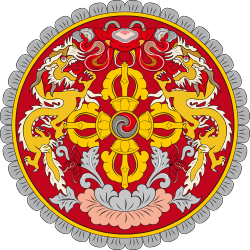Glaciers of Bhutan
The glaciers of Bhutan, which covered about 10 percent of the total surface area in the 1980s, are an important renewable source of water for Bhutan's rivers. Fed by fresh snow each winter and slow melting in the summer, the glaciers bring millions of litres of fresh water to Bhutan and downriver areas each year. Glacial melt also adds to monsoon-swollen rivers which may be a contributing factor to flooding.[1][2] Where glacial movement temporary blocks riverflows, downstream areas may be threatened by glacial lake outburst flood ("GLOFs").[3][4] Although GLOFs are not a new phenomenon in Bhutan, their frequency has risen in the past three decades.[5][6] Significant GLOFs occurred in 1957, 1960, 1968 and 1994, devastating lives and property downstream.[7] According to the Bhutan Department of Energy however, the majority of rivers in Bhutan are more susceptible to fluctuation with changing rainfall patterns than to flooding directly attributable to glacier or snow melt.[8]
Glaciers and glacial lakes
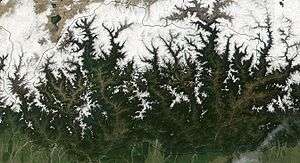
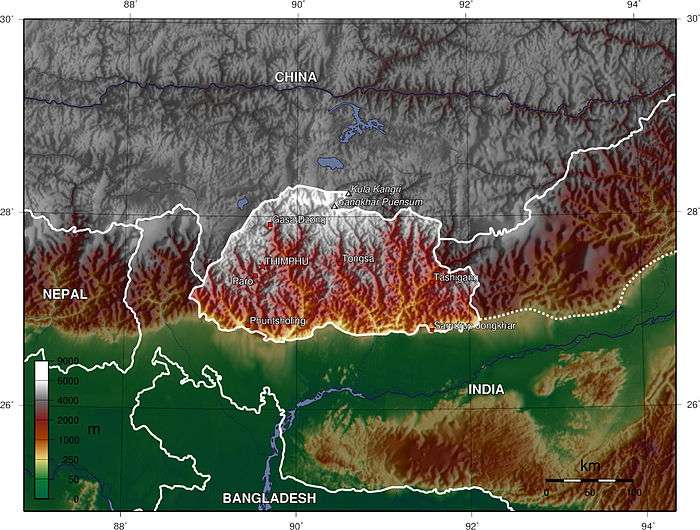
Bhutanese territory contains some 677 glaciers and 2,674 glacial lakes and subsidiary lakes, out of which 25 pose a risk of GLOFs.[5][9] The vast number of glaciers in Bhutan are classed as "valley" and "mountain glaciers," although significant numbers of "ice apron," and "niche glacier" types also exist.[10]:F323 Some glacial lakes, such as Thorthormi Lake in Lunana Gewog, are not a single bodies of water but collections supraglacial ponds.[11] Most glacial lakes identified as potentially dangerous feed into the Manas River and Puna Tsang (Sankosh) River water systems of north-central Bhutan.[12] During a GLOF, residents of nearby downstream villages may have as little as twenty minutes to evacuate; floodwaters from one 1994 GLOF at Luggye lake took about seven hours to reach Punakha, some 90 kilometres (56 mi) downstream.[13]
For public safety, these glaciers and glacial lakes are maintained by the Ministry of Economic Affairs' Department of Geology and Mines, an executive (cabinet) agency of the government of Bhutan.[14] The Department, as part of its environmental "mitigation projects," aims to lower the levels of glacial lakes and thereby avert GLOF-related disaster. In 2001, for example, scientists identified Lake Thorthormi as one that threatened imminent and catastrophic collapse. The situation was eventually relieved by carving a water channel from the lip of the lake to relieve water pressure.[15] The Department uses silent explosives and other means it considers environmentally friendly in order to minimize the ecological impact of its mitigation projects. These projects, however, remain difficult to conduct because of the weather, terrain, and relative lack of oxygen at the glacial lakes' altitudes. As of September 2010, GLOF early warning systems were slated for installation by mid-2011 in Punakha and Wangdue Phodrang Districts at a cost of USD4.2 million.[9][16]
Glacial retreat and controversy
Because the state of glaciers in Bhutan involves questions of climate change, the topic is somewhat controversial. A 2008 United Nations report suggested that due to rising temperatures, glaciers in Bhutan were retreating at a rate of 30–40 meters per year, poised to make many lakes burst their banks and send millions of litres of floodwater downstream. This among many other climate-related issues identified in the report prompted the regional association of government ministers to establish the Southeast Asia Regional Health Emergency Fund in Thimphu in September 2007.[5] Similarly, the member nations of South Asian Association for Regional Cooperation (SAARC) adopted bilateral agreements including measures on climate change and glaciers at its summit in April 2010.[17]
The 2008 UN report also indicated Himalayan glaciers would melt within 25 years,[18] however Prime Minister Jigme Thinley expressed a more dim outlook in a press conference in late March 2010, stating, "Our glaciers are withdrawing very fast and we have reasons to worry that they may in fact disappear not in 2035, but even earlier."[8] Further studies in 2009 indicated the rate of glacial melt in Bhutan was three times the world average, and that over the previous three decades regional temperatures had risen by 2.7 °C (4.86 °F). Satellite imaging also confirmed changes in glaciers and snow peaks, indicating increased runoff and decreased coverage. However, opinions varied on the effect of global warming in the Himalaya.[19] According to US geological survey report, 66 glaciers in Bhutan have decreased by 8.1 percent in the last 30 years.[9]
On the other hand, a study whose results were published in 2011 indicated glacial melt depended on several factors including debris cover, and that more than half of the glaciers in the Himalaya were stable or were in fact growing <Needs source>. Debris cover, such as rocks and mud, set apart the relatively stable glaciers of the Himalaya from the pristine glaciers of the Tibetan Plateau, currently in fast retreat. The study, conducted by the Universities of California and Potsdam and published in the journal Nature Geoscience, was based on 286 glaciers along the Himalaya and Hindu Kush from Bhutan to the Afghanistan-Pakistan border.[18] Another preliminary survey conducted by a team of Japanese and Bhutanese scientists, including a glacio-microbiologist, glacio-ecologist and geologist, indicated that the presence of a peculiar microorganism on the surfaces of glaciers could accelerate glacial melting and eventually lead to a glacial outburst.[20]
List of glaciers and glacier lakes in Bhutan
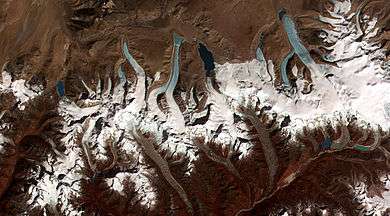
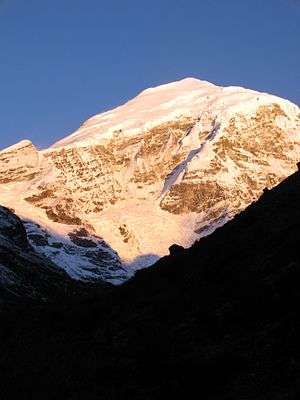
- Lunana glacier group, Laya and Lunana Gewogs, Gasa District (Jigme Dorji National Park)
- Thorthormi Glacier and Lake. Thorthormi Lake, which appeared sometime after 1967, is the largest lake in Lunana, with a width of 30 metres (98 ft).[9][21]
- Raphstreng (Rapstreng) Glacier and Lake. Raphstreng Lake appeared in 1958. It is just over 2 square kilometres (0.77 sq mi) and 107 metres (351 ft) deep.[11][21][22]
- Luggye (Lugge) Glaciers 1, 2, and Lake. Luggye Lake first appeared in 1967, has a depth of 142 metres (466 ft), and a width of 30 metres (98 ft). It produced a significant GLOF in 1994.[11][21][22][23]
- Bechung Glacier and Lake.[11][21]
- Roduphu Glacial Lake, Laya Gewog (Mo Chhu (River) basin).[24]
- Sinchhe Glacial Lake, Laya Gewog (Mo Chhu (River) basin).[24]
- Gangchentag Lake at the base of Gangchentag Mountain, Laya Gewog, Gasa District.[25][26]
- Wochey (Wachey) Glacier and Lake (Pho Chhu (River) basin). It is the single longest glacier in Bhutan at 20.1 kilometres (12.5 mi).[21]
- Northern Basin glacier group, disputed area along the Gasa District-China border (northeast of Jigme Dorji National Park). Runoff from these glaciers flows north into Tibet.[10][12]
- Kuri Chhu (River) basin glacier group, Lhuntse and Trashiyangtse Districts in eastern Bhutan. These small glaciers have very low maximum and minimum elevations, between 5,000 metres (16,000 ft) and 4,000 metres (13,000 ft).[10]
- Teri Kang Glacier and Lake, Laya Gewog (Jigme Dorji National Park). This dam-reinforced lake produced a devastating GLOF in the 1960s, partially destroying Punakha Dzong.[27]
- Gankerphuensum Glacier, near Gankerphuensum (Mangde River basin). At an elevation of approximately 7,500 metres (24,600 ft), it is the highest glacier in Bhutan.[10]
- Jomolhari Glacier, Jomolhari (Chomo Lhāri), Paro District (Pa River basin). At an elevation of 7,300 metres (24,000 ft), it is the second-highest glacier in Bhutan.[10]
- Chubda Glacier and Lake, Bumthang District in north-central Bhutan (upper Chamkhar Chhu basin). Its large supraglacial lake was identified as a potential danger in 2001.[10]
- Tsokar Glacier and Lake, Bumthang District (Chamkhar Chu basin).[24]
See also
References
-

-

- "Fighting glacial lake floods". Bhutan Observer online. 2009-05-22. Archived from the original on 2011-01-19. Retrieved 2011-03-27.
- Dahal, Rabi C (2008-10-31). "Glacial lake outburst a real threat". Bhutan Observer online. Archived from the original on 2011-01-19. Retrieved 2011-03-27.
- Tirwa, Badan (2008-01-19). "Managing health disaster". Thimphu: Bhutan Observer online. Archived from the original on 2011-01-20. Retrieved 2011-03-27.
- "Department of Geology and Mines". Government of Bhutan. 2009-08-25. Retrieved 2011-03-27.
- Rinchen, Sonam (2008-09-16). "Monitoring climate change". Bhutan Observer online. Archived from the original on 2011-01-19. Retrieved 2011-03-27.
- Pelden, Sonam (2010-04-02). "Looking beyond hydropower". Bhutan Observer online. Archived from the original on 2011-10-03. Retrieved 2011-03-27.
- Pelden, Sonam (2010-09-03). "Thorthormi water level brought down 43 cm". Bhutan Observer online. Archived from the original on 2011-01-19. Retrieved 2011-03-27.
- Iwata, Shuji (2010). Richard S. Williams, Jr & Jane G. Ferrigno (ed.). "Glaciers of Bhutan — An Overview" (PDF). Glaciers of Asia: U.S. Geological Survey Professional Paper 1386–F. USGS.
- Pelden, Sonam (2009-10-09). "Thorthormi water level brought down". Bhutan Observer online. Archived from the original on 2011-01-19. Retrieved 2011-03-27.
- "Bhutan's glaciers and glacial lakes". RAO online. 2010-12-05. Retrieved 2011-04-24.
- "Watching the lakes". RAO online. 2010-12-05. Retrieved 2011-04-24.
- "Tengye Lhenkag – Ministry of Economic Affairs". Government of Bhutan. Archived from the original on 2010-07-27. Retrieved 2011-03-27.
- Leslie, Jaques (2013-06-17). "A Torrent of Consequences" (article ]). World Policy Journal, New York, Summer 2013. New York City: World Policy Institute.
- Prime Minister Jigme Thinley (2010-07-02). "Prime Minister's State of the Nation address, 2009–2010 (IV. Environment – Mitigation and Adaptive Measures)". Bhutan Observer online. Archived from the original on 2011-01-19. Retrieved 2011-03-27.
- Pelden, Sonam (2010-04-10). "Summit declaration ready for adoption". Bhutan Observer online. Archived from the original on 2011-01-20. Retrieved 2011-03-27.
- Tshering, Namgay (2011-01-29). "Himalayan glaciers not retreating, says new report". Bhutan Observer online. Archived from the original on 2011-02-07. Retrieved 2011-03-27.
- Bhandari, Achut (2010-12-05). "Cancun climate talks". Bhutan Observer online. Archived from the original on 2011-01-19. Retrieved 2011-03-27.
- "Lunana's glaciers are melting". RAO online. 2010-12-05. Retrieved 2011-04-24.
- Choden, Kuenzang C (2009-08-21). "A major GLOF in 2010?". Bhutan Observer online. Archived from the original on 2011-10-03. Retrieved 2011-03-27.
- Pelden, Sonam (2009-10-21). "Up against the raw nature". Lunana: Bhutan Observer online. Archived from the original on 2012-03-20. Retrieved 2011-03-27.
- "Lakes in Lunana with high GLOF (glacial lake outburst flood) risks". RAO online. 2010-12-05. Retrieved 2011-04-24.
- "Glaciers, Glacial Lakes, and GLOF-related Reports". Department of Geology and Mines. Government of Bhutan. 2007-10-11. Retrieved 2011-04-24.
- "Trip Itinerary for 2011 Takin Festival at Tsharijathang (9–10 June 2011)" (PDF). Tourism Council of Bhutan online. Government of Bhutan. 2011. Archived from the original (PDF) on 1 August 2013. Retrieved 2011-04-24.
- "Keys to Bhutan Adventures and Holidays". Tourism Council of Bhutan online. Government of Bhutan. 2011. Retrieved 2011-04-24.
- "Snowman Trek I (to Sephu)". Tourism Council of Bhutan online. Government of Bhutan. 2008-08-26. Archived from the original on 2011-04-25. Retrieved 2011-04-24.
External links
- "Announcement of Data Release: Glacial Lake Inventory of Bhutan using ALOS (Daichi) Data". Japan Aerospace Exploration Agency. 2011-02-25. Retrieved 2011-07-17.
- "Glacial Lakes in Bhutan Himalayas". Japan Aerospace Exploration Agency. 2008-04-02. Retrieved 2011-03-27.
- "UNDP helps Bhutan to reduce risks of massive glacier lake flooding". UNDP. 2009-09-16. Archived from the original on 2011-07-23. Retrieved 2011-04-24.
- Nayar, Anjali (2009-10-21). "Climate: When the ice melts". Nature online. 461: 1042–1046. doi:10.1038/4611042a. Retrieved 2011-04-24.
